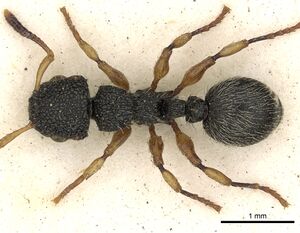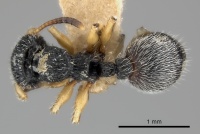Procryptocerus belti
| Procryptocerus belti | |
|---|---|

| |
| Scientific classification | |
| Kingdom: | Animalia |
| Phylum: | Arthropoda |
| Class: | Insecta |
| Order: | Hymenoptera |
| Family: | Formicidae |
| Subfamily: | Myrmicinae |
| Tribe: | Attini |
| Genus: | Procryptocerus |
| Species: | P. belti |
| Binomial name | |
| Procryptocerus belti Forel, 1899 | |
Procryptocerus belti has been collected in both canopy and understory of primary rainforest, in second growth vegetation, in beach-edge vegetation, and in mangroves. Most collections are of foraging workers from low vegetation, but four nest series were collected from narrow-gauge dead stems, at least one of which was detached and lodged in low vegetation. Collections have been made in the canopies of tall trees, including Brosimum, Sloanea, Ficus, and Leuhea. Specimens have been found in the feces of the Cyclopes (silky anteater). (Longino and Snelling 2002)
Identification
Longino and Snelling (2002) - Procryptocerus belti is very similar to Procryptocerus hirsutus. Procryptocerus hirsutus occurs in lowland Amazonia, the Guyanas, and Trinidad and is either parapatric or allopatric with P. belti. Procryptocerus hirsutus is larger (HW 1.0–1.3 mm [n = 7] for P. hirsutus versus 0.88–0.99 mm [mean 5 0.93, n = 12] for P. belti). The mesonotum is longitudinally rugose in P. hirsutus, reticulate rugose in P. belti (with the exception of a specimen from Bugaba, Panama). The outer surface of the metatibia is coarsely rugose in P. hirsutus, relatively smooth in P. belti. The first gastral tergite is always uniformly punctate in P. belti, but in P. hirsutus it is variable, ranging from densely punctate to nearly smooth.
See Procryptocerus pictipes for a discussion of character variation and possible phylogenetic relationships among P. belti, Procryptocerus hirsutus, Procryptocerus convexus, and P. pictipes.
Keys including this Species
Distribution
Latitudinal Distribution Pattern
Latitudinal Range: 18.7942° to -16.99°.
| North Temperate |
North Subtropical |
Tropical | South Subtropical |
South Temperate |
- Source: AntMaps
Distribution based on Regional Taxon Lists
Neotropical Region: Belize, Colombia, Costa Rica (type locality), Ecuador, Guatemala, Honduras, Mexico, Nicaragua, Panama.
Distribution based on AntMaps
Distribution based on AntWeb specimens
Check data from AntWeb
Countries Occupied
| Number of countries occupied by this species based on AntWiki Regional Taxon Lists. In general, fewer countries occupied indicates a narrower range, while more countries indicates a more widespread species. |

|
Estimated Abundance
| Relative abundance based on number of AntMaps records per species (this species within the purple bar). Fewer records (to the left) indicates a less abundant/encountered species while more records (to the right) indicates more abundant/encountered species. |

|
Biology
Longino and Snelling (2002) - In Costa Rica, this species prefers seasonally dry habitats. It is very abundant in the lowlands of the Pacific side, south of Puntarenas, but is rare elsewhere. At La Selva Biological Station, in the wet Atlantic lowlands, it is a very rare element of the ant fauna, occurring sparsely in the tops of canopy trees.
Flight Period
| X | X | X | X | X | X | X | |||||
| Jan | Feb | Mar | Apr | May | Jun | Jul | Aug | Sep | Oct | Nov | Dec |
Source: Kaspari et al., 2001.
- Check details at Worldwide Ant Nuptial Flights Data, AntNupTracker and AntKeeping.
 Explore: Show all Flight Month data or Search these data. See also a list of all data tables or learn how data is managed.
Explore: Show all Flight Month data or Search these data. See also a list of all data tables or learn how data is managed.
Castes
Worker
Images from AntWeb
   
| |
| Syntype of Procryptocerus belti. Worker. Specimen code casent0900227. Photographer Ryan Perry, uploaded by California Academy of Sciences. | Owned by NHMUK, London, UK. |
   
| |
| Neolectotype of Procryptocerus belti. Worker. Specimen code casent0904894. Photographer Z. Lieberman, uploaded by California Academy of Sciences. | Owned by MSNG, Genoa, Italy. |
Nomenclature
The following information is derived from Barry Bolton's Online Catalogue of the Ants of the World.
- belti. Procryptocerus belti Forel, 1899c: 46, pl. 3, fig. 6 (w.q.m.) COSTA RICA. See also: Kempf, 1951: 31; Longino & Snelling, 2002: 11.
Unless otherwise noted the text for the remainder of this section is reported from the publication that includes the original description.
Description
Worker
Longino and Snelling (2002) - (n = 1, Costa Rica): HW 0.991 (range 0.88–0.99, mean 0.93, n 5 12), HL 0.976, SL 0.645, EL 0.280, MeL 1.166, MeW 0.686, PrW 0.478, PrL 0.241, PrS 0.241, PrT 0.483, MTL 0.626, PtL 0.331, PtW 0.302, PpW 0.419, PtH 0.316, AL 1.179, AW 1.034.
Head subtriangular in outline, margin of vertex approximately straight; face with uniform areolate sculpture; frontal carina extends onto clypeus; separated from and passing above torulus as a differentiated carina; face to margin of vertex with regular honeycomb-like areolate sculpture; clypeus at level of antennal insertions abruptly bent ventrad; clypeus with prominent median carina, very faint longitudinal striae laterally; genae with closely spaced foveae; genal bridge longitudinally striate; mandible granular, subopaque, with weak longitudinal striae; in anterior view, eyes asymmetrically convex, skewed ventrad; scape flattened with thick lateral margin distally, becoming narrower and more terete basally, then flaring into a basal flange; broad flat surface of scape finely areolate, outer lateral margin with coarse rugae; margin of vertex angulate but smooth, not crestlike or crenate; vertex largely smooth and shiny, with a few faint striae radiating from occiput.
Mesonotum convex, forming continuous curve with pronotum; in dorsal view, lateral lobes of mesonotum obsolete, visible at other angles as short, obtuse teeth; propodeal suture a broad, shallow trough; anterolateral propodeal lobes indistinct, small obtuse teeth a short distance posterior to anterolateral margin; promesonotum coarsely foveate anteriorly, becoming reticulate rugose on mesonotum (a specimen from Bugaba, Panama, with posterior half of the mesonotum longitudinally rugose, thus approaching Procryptocerus hirsutus, but otherwise similar to typical Central American belti); irregular parallel longitudinal striae on dorsal face of propodeum, approximately 10 striae across at level of lateral lobes; posterior face of propodeum perpendicular to dorsal face, posterior face flat; posterior face of propodeum completely smooth and shining; parallel longitudinal striae cover lateral pronotum, anepisternum, katepisternum, and lateral propodeum; approximately six irregular striae on lateral pronotum, grading into foveae dorsally, and one or two on anepisternum, of similar size to those on pronotum; approximately eight striae extend unbroken across katepisternum and lateral propodeum, these contrastingly smaller; posterior surface of forefemur entirely smooth and shining; outer surface of metatibia granular, with a few very faint rugae.
Ventral margin of petiole weakly concave, ending anteriorly in very small, obtuse tooth; anterodorsal face of petiole smooth and shiny; posterodorsal face coarsely foveate-rugose; postpetiole with flat anterodorsal face, short sloping posterior face; ventral margin of postpetiole short, with a prominent, acute anterior tooth; dorsum of postpetiole coarsely foveate-rugose; first gastral tergite densely and finely punctate throughout; first gastral sternite densely and finely punctate laterally and anteriorly, punctation fainter on disc; second gastral tergite with faint, dense, granular sculpture.
Short stiff setae (>100) distributed uniformly on face; abundant stiff setae on mesosomal dorsum (>20 on central area of promesonotum, not including those on lateral margins), longer than those on face; setae on petiole and postpetiole abundant, longer than those on mesosomal dorsum; first gastral tergite with dense, long stiff setae, grading continuously from suberect to decumbent; color shining black, with legs and antennae contrastingly light orange-brown.
Queen
Longino and Snelling (2002) - (n = 1, Costa Rica): HW 0.92, HL 0.90, SL 0.60, EL 0.27, MeL 1.34, MeW 0.75, MTL 0.59, PtL 0.34, PtW 0.29, PpW 0.43, PtH 0.30, AL 1.14, AW 1.05.
Similar to worker in most respects; pronotum, mesoscutum, axillae, and scutellum coarsely foveate and covered with a dense stubble of stiff, erect setae; foveae of mesoscutum somewhat elongate; dorsal face of propodeum longitudinally striate.
One of the two paralectotype queens at MCSN is aberrant. Unlike typical P. belti workers and queens, this queen has greatly reduced erect setae on the gaster. The queen is typical in all other respects. A queen collected from a treefall in Corcovado National Park, Costa Rica, is similarly aberrant, with greatly reduced setae on both the gaster and the mesosoma. This queen was collected along with absolutely typical workers.
Type Material
Longino and Snelling (2002) - Lectotype worker, two paralectotype queens, one paralectotype male: Costa Rica, Nicoya (Alfaro) Musee d'Histoire Naturelle Genève (queens and male examined); paralectotype workers, queens, males: same data Museo Civico di Storia Naturale, Genoa (examined, one worker here designated neolectotype).
Kempf (1951:31) examined and described a syntype worker from MHNG and designated it lectotype. There are only one male and two alate queens from the Nicoya series at MHNG (Kempf designated these paratypes, without examination). The specimen examined by Kempf is not at MZSP and is apparently missing. The original Nicoya series originated from Emery’s collection MCSN, where there still reside two workers, three males, and two queens.
References
- Forel, A. 1899d. Formicidae. [part]. Biol. Cent.-Am. Hym. 3: 25-56 (page 46, pl. 3, fig. 6 worker, queen, male described)
- Guerrero, R.J., Fernandez, F., Escarraga, M.E., Perez-Pedraza, L.F., Serna, F., Mackay, M.P., Sandoval, V., Vergara, V., Suarez, D., Garcia, E.I., Sanchez, A., Meneses, A.D., Tocora, M.C., Sosa-Calvo, J. 2018. New records of myrmicine ants (Hymenoptera: Formicidae) for Colombia. Revista Colombiana de Entomología 44: 238-259 (DOI 10.25100/socolen.v44i2.7115).
- Kaspari, M., Pickering, J., Longino, J., Windsor, D. 2001. The phenology of a Neotropical ant assemblage: evidence for continuous and overlapping reproduction. Behavioral Ecology and Sociobiology 50, 382–390 (doi:10.1007/s002650100378).
- Kempf, W. W. 1951. A taxonomic study on the ant tribe Cephalotini (Hymenoptera: Formicidae). Rev. Entomol. (Rio J.) 22: 1-244 (page 31, see also)
- Longino, J.T. and Snelling, R.R. 2002. A taxonomic revision of the Procryptocerus of Central America. Contributions in Science. 495:1-30.
- Yanoviak, S.P., Frederick, D.N. 2014. Water surface locomotion in tropical canopy ants. Journal of Experimental Biology 217, 2163–2170 (doi:10.1242/jeb.101600).
References based on Global Ant Biodiversity Informatics
- Adams B. J., S. A. Schnitzer, and S. P. Yanoviak. 2019. Connectivity explains local ant community structure in a Neotropical forest canopy: a large-scale experimental approach. Ecology 100(6): e02673.
- Castano-Meneses, G., M. Vasquez-Bolanos, J. L. Navarrete-Heredia, G. A. Quiroz-Rocha, and I. Alcala-Martinez. 2015. Avances de Formicidae de Mexico. Universidad Nacional Autonoma de Mexico.
- Dattilo W. et al. 2019. MEXICO ANTS: incidence and abundance along the Nearctic-Neotropical interface. Ecology https://doi.org/10.1002/ecy.2944
- Fernández, F. and S. Sendoya. 2004. Lista de las hormigas neotropicales. Biota Colombiana Volume 5, Number 1.
- INBio Collection (via Gbif)
- Kempf W. W. 1951. A taxonomic study on the ant tribe Cephalotini (Hymenoptera: Formicidae). Revista de Entomologia (Rio de Janeiro) 22:1-244
- Kempf, W.W. 1972. Catalago abreviado das formigas da regiao Neotropical (Hym. Formicidae) Studia Entomologica 15(1-4).
- Longino J. T. 2013. Ants of Nicargua. Consulted on 18 Jan 2013. https://sites.google.com/site/longinollama/reports/ants-of-nicaragua
- Longino J. T. and Snelling R. R. 2002. A taxonomic revision of the Procryptocerus (Hymenoptera: Formicidae) of Central America. Contributions in Science (Los Angeles) 495: 1-30
- Longino J. et al. ADMAC project. Accessed on March 24th 2017 at https://sites.google.com/site/admacsite/
- Maes, J.-M. and W.P. MacKay. 1993. Catalogo de las hormigas (Hymenoptera: Formicidae) de Nicaragua. Revista Nicaraguense de Entomologia 23.
- Mirmecofauna de la reserva ecologica de San Felipe Bacalar
- Vásquez-Bolaños M. 2011. Lista de especies de hormigas (Hymenoptera: Formicidae) para México. Dugesiana 18: 95-133

